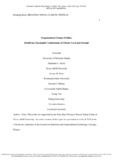- CERES Home
- →
- School of Management (SoM)
- →
- Staff publications (SoM)
- →
- View Item
JavaScript is disabled for your browser. Some features of this site may not work without it.
| dc.contributor.author | He, Yimin | |
| dc.contributor.author | Payne, Stephanie C. | |
| dc.contributor.author | Beus, Jeremy M. | |
| dc.contributor.author | Muñoz, Gonzalo J. | |
| dc.contributor.author | Yao, Xiang | |
| dc.contributor.author | Battista, Valentina | |
| dc.date.accessioned | 2022-10-25T08:25:16Z | |
| dc.date.available | 2022-10-25T08:25:16Z | |
| dc.date.issued | 2022-10-13 | |
| dc.identifier.citation | He Y, Payne SC, Beus JM, et al., (2023) Organizational climate profiles: Identifying meaningful combinations of climate level and strength. Journal of Applied Psychology, Volume 108, Issue 4, April 2023, pp. 595-620 | en_UK |
| dc.identifier.issn | 0021-9010 | |
| dc.identifier.uri | https://doi.org/10.1037/apl0001036 | |
| dc.identifier.uri | https://dspace.lib.cranfield.ac.uk/handle/1826/18597 | |
| dc.description.abstract | According to situation strength theory, organizational climate should have a stronger effect on group behavior when members’ perceptions of the climate are both unambiguous (i.e., very high or very low) and shared than when they are more ambiguous and less shared. In the organizational climate literature, this proposition is typically examined by testing the interaction between climate level (i.e., mean) and strength (i.e., variability); surprisingly, the preponderance of empirical research testing this interaction does not support this theoretical expectation. This may be because the traditional variable-centered approach fails to consider the possibility of overlooked subpopulations consisting of unique combinations of climate level and strength, creating distinct climate profiles. To address this issue, we use a group-centered conceptualization and analyses (i.e., latent profile analysis) to examine the extent to which 302 workgroups (Sample 1) and 107 organizations (Sample 2) evidence statistically and practically meaningful climate profiles. Results revealed four to six distinct climate profiles across multiple climate types were differentially associated with theoretically relevant outcomes, including objective financial measures. Consistent with situation strength theory, groups with strong and favorable profiles tended to have more positive outcomes, whereas groups with weaker, less favorable profiles tended to have less positive outcomes. In contrast, the traditional variable-centered approach was generally unsupportive of an interaction between climate level and strength. Overall, these findings provide evidence that the group-centered approach is a more sensitive statistical modeling technique for testing a fundamental tenet of situation strength theory in the context of organizational climate research. | en_UK |
| dc.language.iso | en | en_UK |
| dc.publisher | American Psychological Association | en_UK |
| dc.rights | Attribution-NonCommercial 4.0 International | * |
| dc.rights.uri | http://creativecommons.org/licenses/by-nc/4.0/ | * |
| dc.subject | organizational climate | en_UK |
| dc.subject | latent profile analysis | en_UK |
| dc.subject | safety performance | en_UK |
| dc.title | Organizational climate profiles: Identifying meaningful combinations of climate level and strength | en_UK |
| dc.type | Article | en_UK |
Files in this item
The following license files are associated with this item:
This item appears in the following Collection(s)
-
Staff publications (SoM) [1263]

